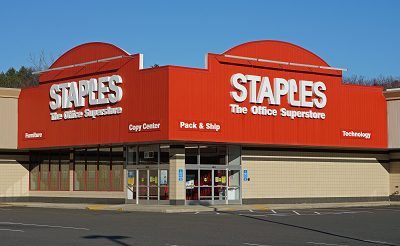The $6.9 billion buyout of Staples by private equity firm Sycamore Partners wasn’t exactly a shock to retail industry observers. Following the failure of its merger with Office Depot in 2016 and 14 straight quarters of same-store sales declines, either a buyout or a bankruptcy became increasingly likely.
Now that the shoe has dropped, the guessing game becomes tougher. Going private could give Staples the breathing room to make long-term changes without facing the quarterly scrutiny of Wall Street. On the other hand, Sycamore Partners might seek a quick profit by selling off assets while radically shrinking the business.
Assuming Sycamore is in it for at least the foreseeable future, Staples executives, under the leadership of CEO Shira Goodman, are likely to accelerate the retailer’s move into the B2B space. This would likely involve trimming the brand’s 1,500-location store count, cutting staff and moving even more aggressively into digital sales. E-Commerce currently accounts for 60% of sales, and that figure is projected to rise to 80% by 2020. It’s even possible that Staples could take another shot at merging with Office Depot, gambling on a more business-friendly Federal Trade Commission under the Trump administration.
Advertisement
No matter what actions Staples takes, the retailer must deal with competition from Amazon and the long-term decline in consumption of traditional office supplies (paper and ink) as business becomes increasingly digital.
The RetailWire Brain Trust recently discussed whether Staples can successfully reinvent itself under private ownership and what this “new” Staples might look like.
Ryan Mathews, Founder, CEO, Black Monk Consulting
Going private is a major first step toward buying Staples the freedom it needs to make the changes necessary for not just survival, but profitable growth. And Shira Goodman is as good an analytic thinker as you can find running a retail organization. That said, I would like to see that freedom and that analytic power addressing a more creative positioning than traditional “B2C” and/or “B2B.”
The world has changed significantly and, frankly, the business services space is about as crowded as outsourced tech support and repairs. What Staples needs is a bold redefinition of mission. Why fight for the right to be the lowest-cost provider of printer paper or ink — whether to individuals or corporations — when you could be using your newfound freedom to reinvent the rules of the game?
Staples’ executives might ask themselves provocative questions such as, What could an office products retailer be if it wasn’t focused on traditional retailing of office products, on or offline? It seems old rock ‘n rollers go to Memphis to live out the ends of their careers. In the same way, business services has become the “Memphis” of office products companies. So is the right path for Staples to be the retail equivalent of Xerox, or are there more profitable and less competitive options for its future?
I think the answer is yes but — as always — only time will tell.
Charles Dimov, Director of Marketing, OrderDynamics
Staples has upped its game on the technology side. They sell more laptops, desktops, printers, networking hardware and tech gear than they have in the past. To make the service part stick, privatization gives them the breathing room to tinker with an experience center like the Apple stores. Doing this would hook SMB and micro-SMB customers with the appeal of being trusted tech brains. Expanding the customer experience could pay dividends, even if it takes some time to deploy.
Art Suriano, CEO, The TSi Company
I hate being the negative guy here but I do not see real long-term success for Staples under the ownership of Sycamore Partners. Staples may have had only $1 billion in debt, but once they complete the deal, Staples will have that $1 billion plus the $6.9 billion Sycamore paid for the company. As with many private equity firms, they will strip out assets wherever possible and turn them into cash. So what do I see? The usual private equity takeover. The stockholders are elated because they make a killing, but in time if sales do not reach the goals (and often they’re unattainable), we’ll eventually put Staples on the list along with Sports Authority, Gordmans and others where the only people who come out ahead are those at the private equity firm.
Lyle Bunn, Strategy Architect — Digital Place-based Media
Better customer experience in-store and better links to customers that activate store visits are the next step in Staples’ success. Activating supplier information to provide product features and benefits that enable the comparison shopper, endless aisle, inventory visibility with ship-to-store or home/office and better wayfinding should be top priorities. The Genius Bar/Geek Squad approaches to sales support and activating service revenues are bigger changes that will generate more revenue through improved service and customer experience. In their change management framework, immediate wins can be realized by implementing more digital experiences, which will serve to better engage suppliers in the retail partnership. Staples has nowhere to go but up in this robust retail category.
JJ Kallergis, Retail Industry Advisor, Softtek
As Marc Benioff once said, speed is the new currency of business. If Staples understands this and doubles down on its B2B focus, they could bridge the gap between physical retail and digital/tech support through a hybrid in-store/remote tech support service similar to CDW. SMB owners and end users could essentially pop in for services to the stores instead of paying for an internal IT staff, which could be cost prohibitive. This would entail a large transformation and clearly one more easily achievable with private ownership.
Craig Sundstrom, CFO, Weisner Steel
It’s hard for me to understand what Sycamore is after here. The traditional explanation is that a company was “underperforming” and so the new owners turn things around and sell the new and improved entity for a profit. Sometimes that’s a reality, and sometimes it’s just a fable — the “new improved” model has been stripped under the hood, and is sold to unsuspecting buyers. But what evidence of “underperformance” is there here? It seems — to most of us, I’m sure — that the paper and ink business is in a long-term death march, and even worse, everyone knows it. Perhaps Sycamore doesn’t believe that, and maybe they have the numbers to support their faith, but it’s hard to see it from the outside.









